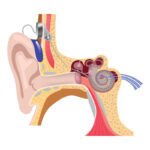Dual Hearing Aids: Evaluating the Advantages and Disadvantages
Hearing loss can significantly impact a person's quality of life, making communication difficult and leading to feelings of isolation and frustration. Fortunately, hearing aids can help alleviate these issues by amplifying sounds and improving speech clarity. While hearing aids come in many different shapes and sizes, one option that has become increasingly popular in recent years is dual hearing aids. In this blog post, we'll take a closer look at dual hearing aids, examining their advantages and disadvantages to help you decide if they're right for you.
What is Dual Hearing Aids?

Dual hearing aids are an innovative type of hearing aid that offer several advantages over traditional hearing aids. They are designed to be worn in both ears, and their primary advantage lies in their ability to work together to provide a more natural and immersive listening experience.
Traditional hearing aids only amplify sound in one ear, which can lead to an unbalanced and unnatural listening experience. In contrast, dual hearing aids process sound signals from both ears simultaneously, allowing the brain to better understand and interpret sounds.
This can be especially helpful in situations where it is important to pick out specific sounds, such as in a crowded restaurant or during a conversation with multiple people. The brain is better able to filter out unwanted sounds and focus on the sounds that are most important, which can lead to a more enjoyable and stress-free listening experience.
Additionally, dual hearing aids can help reduce the effects of hearing loss on the brain, as they provide a more complete and accurate representation of the sounds around you. Overall, the use of dual hearing aids can significantly improve the quality of life for individuals with hearing loss.
Advantages of Dual Hearing Aids
- Improved sound quality
One of the biggest advantages of dual hearing aids is that they provide a more natural and immersive listening experience. By processing sound signals from both ears, dual hearing aids can improve sound quality and clarity, making it easier to understand speech and other sounds. This can be especially helpful in noisy environments, where it can be difficult to pick out individual sounds.
- Better localization
Localization refers to the ability to determine the direction of a sound. Dual hearing aids can improve localization, making it easier to determine the direction of a sound source. This can be especially helpful in situations where it is important to identify the location of a sound, such as in traffic or when trying to identify the source of a fire alarm.
- Increased speech recognition
Dual hearing aids can also improve speech recognition, making it easier to understand conversations. This is because the brain uses input from both ears to process speech, and dual hearing aids can provide a more complete picture of the sounds around you. This can be especially helpful in situations where there is background noise, as dual hearing aids can help filter out unwanted sounds and improve speech recognition.
- Better balance
Wearing hearing aids in both ears can also help improve balance, as the brain uses input from both ears to maintain balance. This can be especially helpful for older adults, who may be at a higher risk of falls due to balance issues.
- Reduced feedback
Feedback, which is the high-pitched whistling sound that can occur when a hearing aid is too close to a sound source, can be a common issue with hearing aids. However, dual hearing aids can help reduce feedback, as they can process sounds from both ears and adjust the volume levels accordingly.
Disadvantages of Dual Hearing Aids
- Higher cost
Dual hearing aids can be more expensive than traditional hearing aids, as you will need to purchase two hearing aids instead of one. However, many insurance plans and hearing aid providers offer financing options to help make dual hearing aids more affordable.
- Higher maintenance
Maintaining two hearing aids can be more time-consuming and expensive than maintaining one. You will need to replace batteries and clean both hearing aids regularly to keep them functioning properly.
- Adjustment period
It can take some time to adjust to wearing dual hearing aids, as your brain will need to learn how to process sound signals from both ears. This adjustment period can vary from person to person but can take several weeks or even months.
- Compatibility issues
Not all hearing aids are compatible with each other, which means that you may not be able to mix and match brands or models of hearing aids. This can limit your options when it comes to choosing dual hearing aids.
- Possible discomfort
Wearing two hearing aids can be more uncomfortable than wearing one, especially if you are not used to having something in both ears. However, most people find that the benefits of dual hearing aids outweigh any initial discomfort.
How to Decide if Dual Hearing Aids are Right for You

If you are considering dual hearing aids, there are several factors you should take into account before making a decision. These include:
- Degree of hearing loss: Dual hearing aids may be more beneficial for individuals with severe to profound hearing loss, as they can provide a more immersive listening experience.
- Lifestyle: If you spend a lot of time in noisy environments or need to be able to identify the direction of sounds, dual hearing aids may be a good choice for you.
- Budget: Dual hearing aids can be more expensive than traditional hearing aids, so it's important to consider your budget and explore financing options.
- Comfort: While it's normal to experience some discomfort when adjusting to hearing aids, it's important to choose a hearing aid that feels comfortable and doesn't cause pain or irritation.
- Compatibility: If you already have a hearing aid and are considering adding a second one, it's important to make sure they are compatible with each other.
Conclusion
Bilateral fitting of hearing aids offers several benefits, such as improved binaural interaction, directional hearing, and speech perception in noisy environments. However, there are also some disadvantages, such as binaural interference, which reduces the ability to detect speech and other binaural cues. The efficacy of bilateral amplification is most beneficial to patients with mild hearing impairment, but further research is needed to determine whether it has significant benefits for other domains. Patients must consult with an audiologist to determine the best treatment plan for their specific needs.
Sources
Lacher-Fougère, S., & Demanez, L. (2020). Dual Hearing Aids: Evaluating the Advantages and Disadvantages. Audiology Research, 10(1), 266. doi: 10.4081/audiores.2020.266
Link: https://www.ncbi.nlm.nih.gov/pmc/articles/PMC7592763/
Gosselin, P. A., & Gagné, J. P. (2011). Listening effort and fatigue in school-age children with and without hearing loss. Journal of Speech, Language, and Hearing Research, 54(5), 1417-1430. doi: 10.1044/1092-4388(2011/10-0246)
Link: https://pubs.asha.org/doi/abs/10.1044/1092-4388(2011/10-0246)







